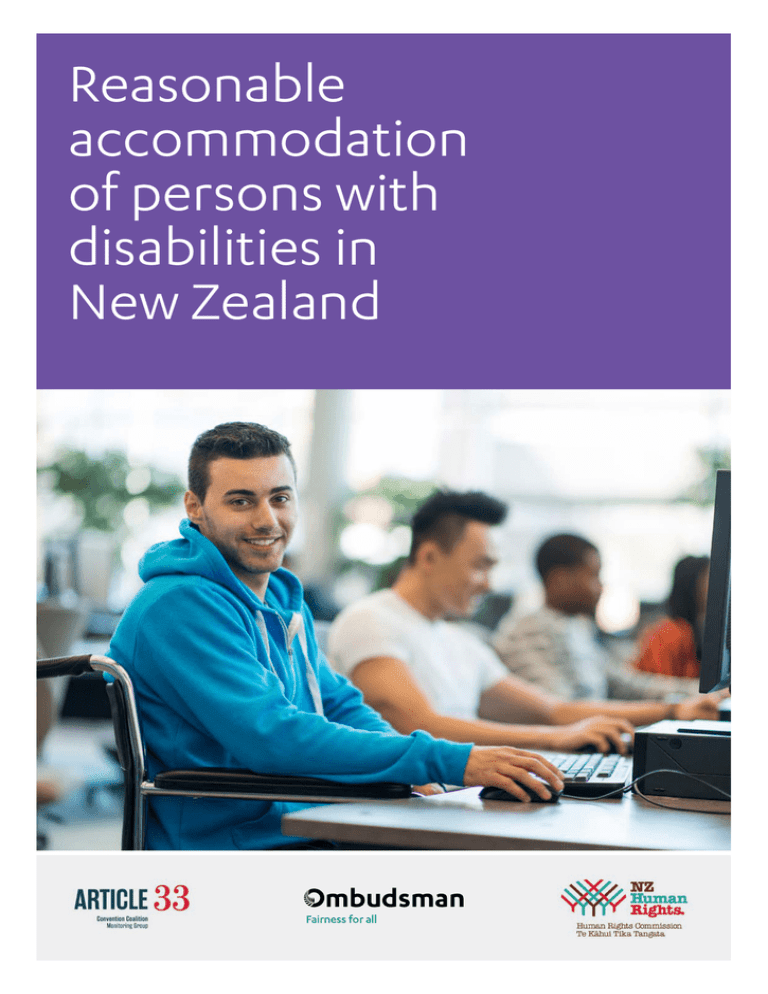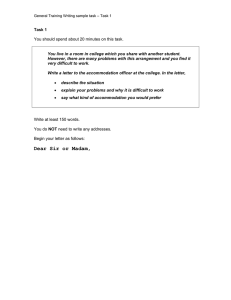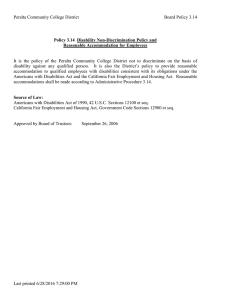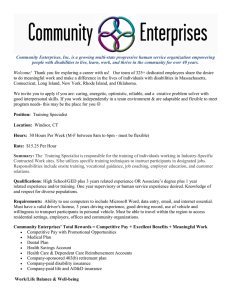Reasonable Accommodation Guide
advertisement

Reasonable accommodation of persons with disabilities in New Zealand 1 What does reasonable accommodation mean? The term reasonable accommodation refers to an adjustment made in a system and based on a proven need to accommodate an individual with a disability. Reasonable accommodation is a key concept in the United Nations Convention on the Rights of Persons with Disabilities (the Convention), which has been ratified by many countries, including New Zealand. Article 2 of the Convention defines reasonable accommodation as: »» necessary and appropriate modification and adjustments; »» not imposing a disproportionate or undue burden; »» where needed in a particular case; »» to ensure to persons with disabilities the enjoyment or exercise on an equal basis with others of all human rights and fundamental freedoms. Agencies should be aware of the obligation to provide reasonable accommodation both to staff and in all aspects of service delivery and decision making. For instance, in the areas of education, employment, provision of public information and services, access to facilities, the provision of goods and services, the built environment and housing. Persons with a disability may make a request for reasonable 2 accommodation if they consider they are disadvantaged by the way a system or service operates. The duty to provide reasonable accommodation to persons with disabilities can vary significantly, and often takes into account many different aspects of society and how it operates. For instance, an individual with a visual impairment may require larger text on printed documents so this information is easy for them to read. Reasonable accommodation might involve a person assisted by a wheelchair being provided with an accessibility ramp to enter a public building. Ensuring reasonable accommodation often costs very little or nothing at all, and can be as simple as changing attitudes, means of communication, or improving accessibility. Some of these things are common courtesy. At other times agencies may need to make more fundamental changes, in order to ensure systems are designed to accommodate persons with disabilities. You may wish to consult the appendix attached to this brochure if you are looking for more detailed information on the legal context of reasonable accommodation in New Zealand. Ensuring equality and overcoming barriers Society and systems should not discriminate against persons with any type of disability, including those who have physical, visual, hearing, speech, intellectual or mental impairments. If persons with disabilities are unable to enjoy the same rights as other members of society, it may be that reasonable accommodation is not being provided. The types of barriers that make it difficult (or sometimes impossible) for persons with disabilities to be accommodated include: Architectural and physical – these include features of buildings and spaces that cause navigational difficulties for people with disabilities. For instance, hallways or walkways that are too narrow to accommodate a person using a wheelchair. Information or communication – these occur when an individual is unable to easily understand information in the manner it has been presented. For example, print that is too small to be read by a person with a visual impairment. 3 Attitudinal – these occur when a person with a disability is discriminated against purposely or inadvertently. For instance, assuming that a person with a speech impediment cannot understand directions provided to them. Technological – these include when technology has not been modified to support a person who uses assistive devices. For example, a website which does not support screen-reading software. Systemic – these include policies, practices or procedures which discriminate against people with disabilities. For instance, a recruiting process which is not open to some persons with a disability. Reasonable accommodation can help to overcome these barriers, and positive action can eliminate the barriers altogether! What is considered reasonable? Interpretation of what is considered reasonable is not always agreed, and law in this area is evolving in New Zealand and internationally. However, it is important that agencies bear in mind the need to provide reasonable accommodation in all actions, services and decision making. Individual requests for reasonable accommodation must be considered constructively and careful thought given as to whether any modifications can be made to assist persons with disabilities. The Human Rights Act 1993 makes it unlawful to discriminate against a person because of a disability in relation to employment matters, provision of goods and services, access to public places and facilities and other specified situations. The legal requirements governing each of these situations, and the exceptions that apply, vary slightly in different circumstances. Generally, if it is reasonable for a person or organisation to take steps or make changes to accommodate the requirements of a person with a disability, then they may be required to do so. If they do not, then this may amount to unlawful discrimination in terms of the Human Rights Act. What is “reasonable” will depend on a number of factors including the specific legal provisions that apply, the facts of a particular case, any costs involved, and whether the required actions could pose a risk to other people. 4 Factors to take into account when considering what amounts to reasonable accommodation include: »» the effectiveness of any adjustment in assisting persons with disabilities to access, interact and/or work in society; »» whether it is practical to make an adjustment; »» the financial (or other costs) associated with the adjustment; »» the availability of resources to undertake an adjustment; and »» how much disruption, if any, will be caused to other people by the adjustment. Individual requests for reasonable accommodation should be considered on a case-by-case basis. Every effort should be made to accommodate persons with disabilities, and in circumstances where this is not practical, alternative options should be explored. 5 Examples of requests for reasonable accommodation being positively acted on: A grocery store decides to widen aisles and checkout lanes after a customer experiences difficulty navigating these in their wheelchair. This action also assists people with visual impairments, and customers accompanied by young children. An employee advises their manager that due to their visual impairment it is difficult for them to review work-related documents that are frequently published in PDF format. Their manager then arranges for work-related documents to be available in both Microsoft Word and PDF format. The employee can then change the text size using Microsoft Word to suit their needs. A school has a blanket policy stating that students are not allowed to eat during lessons. However, after enrolling a student with advanced diabetes it allows this pupil to have a supply of food on hand to ensure their blood sugar level is kept at an appropriate level. Examples of requests for reasonable accommodation being declined but met in an alternative way: A client with a physical impairment requests that an organisation installs an elevator because they find using the accessibility ramp provided difficult. After considering this request the organisation declines to undertake this request based on cost, but works with the individual to assist them using the accessibility ramp when visiting the organisation. An individual who is blind requests that their local swimming pool provides a lane for swimmers with visual impairments. Staff at the pool decline this request due to a very high volume of patrons leading to already overcrowded swimming lanes. However, staff liaise with the individual regarding their regular swimming schedule, and do their best to ensure there is space available during these times. A construction worker partially paralysed after an accident cannot retain their former position because it requires full physical capacity. They request to continue performing parts of the job but their employer declines this request based on health and safety reasons. However, their employer assists them to find another skilled job within the company. Guidance for organisations Benefits associated with providing reasonable accommodation Changes you make to accommodate people with disabilities can: »» make your service or workplace more accessible to a wider market; 6 Profile your organisation Providing reasonable accommodation can be considered as part of your organisation’s profile. For instance: »» Do you advertise your services or vacancies in ways that ensure that persons with disabilities can find out about them? »» make your premises easy to get around; »» prime staff to respond to the needs of all persons; »» How do you let persons with disabilities know what steps you have taken, or will take, to ensure that your services are available and accessible? »» make everybody feel valued; and »» provide a service which people want to return to. Providing reasonable accommodation to persons with disabilities can also: »» benefit the general public or your staff; »» broaden your potential customer/service base; »» enhance your positive public image; »» enhance your competitiveness; and »» encourage corporate social responsibility. »» What steps can you take to ensure that you are communicating effectively with persons with disabilities? Policies and procedures It is useful to consider your organisation’s policies and procedures with the concept of reasonable accommodation in mind. For instance: »» Do you have plans that take into account the needs of persons with disabilities? Do you promote an inclusive and responsive approach when assisting persons with disabilities? »» Do you have policies in place that may inadvertently discriminate against persons with disabilities (i.e. no dogs allowed on the premises)? »» Do you provide staff with disability awareness training? 7 Service provision Universal Design Consider whether the services you currently provide proactively seek to accommodate and assist persons with disabilities. For instance: Universal design (also known as inclusive design) refers to the creation of buildings, products and environments that are accessible to older persons, persons with disabilities, and persons without disabilities. »» Are your premises easy to get into and get around? »» Are goods, services and facilities signposted on your premises? Are they noticeable, legible and understandable? »» Are you informed on contemporary methods of making your goods, services or facilities accessible? »» Have you considered whether the communication technologies you utilise are accessible and people with impairments have flexibility if a particular method of contact does not work for them? »» Are customer service points visible and easily accessible? »» Do you effectively encourage persons with disabilities to ask for their needs to be met? Remember: Every reasonable effort should be made to accommodate persons with disabilities, and in circumstances where this is not practical, alternative options should be explored. It is important to clearly communicate with the individual who has asked for reasonable accommodation throughout your consideration of their request, and advise of any actions you will, or will not, be taking. Universal design is defined in Article 2 of the Convention as: “the design of products, environments, programmes and services to be usable by all people, to the greatest extent possible, without the need for adaptation or specialist design”. Encouraging universal design at the outset is one way to try to ensure persons with disabilities are reasonably accommodated. Universal design often negates the need for individual adaption as it promotes widespread access and availability in the development of facilities, standards and guidelines. The concept of universal design encourages thinking about the lifetime of a structure or service during its initial development, along with the types of people who will need to utilise that structure or service over time. Again, this reduces the likelihood of having to make adaptions in future. Some of the key principles of universal design include: »» Equitable use – ensuring the design is useful and marketable to people with diverse abilities; »» Flexibility in use – ensuring the design accommodates a wide range of individual preferences and abilities; 8 »» Simple and intuitive use – ensuring the design is easy to understand, regardless of the user’s experience, knowledge and language skills; »» Effective communication – ensuring the design communicates necessary information effectively and obviously; »» Tolerance for error – ensuring the design minimises hazards and adverse consequences of accidental or unintended actions; »» Low physical effort – ensuring the design can be used effectively and comfortably with a minimum of fatigue; and »» Sensible size and space – ensuring the design is of appropriate size and space that allows approach, reach and easy use, regardless of the user’s body size, posture or mobility. Resources The following links provide useful information that may assist to ensure reasonable accommodation is being provided: Accessibility and mobility Standards New Zealand has put together a useful document entitled ‘Design for Access and Mobility – Buildings and Associated Facilities’ which can be located at: http:// www.standards.co.nz/assets/Publication-files/ NZS4121-2001.pdf. Employment Workbridge is the largest New Zealandowned employment agency for persons with a disability. It provides information for jobseekers with a disability, employers and workplaces and can be found online at: http:// www.workbridge.co.nz. New Zealand Legislation The Parliamentary Counsel Office has developed a website that is an authoritative source on Acts, Bills and Legislative Instruments in New Zealand. The website includes a search function and we suggest you use the search terms “disability”, “reasonable” and “accommodation”. This tool can be found online at: http://www.legislation.govt.nz/ searchadvanced.aspx. Office for Disability Issues The Office for Disability Issues has put together a page of resources which provides useful guidance around reasonable accommodation, and can be found online at: http://www.odi.govt.nz/resources/guides-andtoolkits/disability-perspective/eliminatingaccess-barriers.html. Online information and standards The New Zealand Government Web Accessibility Standard requires core Government agencies to deliver online information and services that are accessible to persons with disabilities. The Web Accessibility Standard and related guidance are maintained by the Department of Internal Affairs and can be found online at: https://webtoolkit.govt.nz. Guidance for persons with disabilities Your rights relating to reasonable accommodation You have a number of rights relating to reasonable accommodation, including: »» a right to make reasonable requests for accommodation to enable you to access the services you need; »» a right to inform organisations or employers about what you need if you experience obstacles or problems accessing or using systems; »» a right to be listened to and have your concerns taken seriously; »» a right to remind providers or employers that providing reasonable accommodation helps to ensure persons with disabilities can be productive, and make valuable contributions to society; and »» a right to request information about actions an organisation has taken, or has not taken, in response to your request for reasonable accommodation. 9 Tips to ensure you effectively communicate your request for reasonable accommodation When approaching an organisation to request reasonable accommodation it may be useful to: »» make enquiries about the policies and procedures the organisation has in place for assisting persons with disabilities. Ask what you can expect from the process, including how your request will be considered, and how the outcome will be communicated to you; »» provide evidence of why you are requesting reasonable accommodation, and give examples of how the current arrangements do not suit your needs; »» carefully explain exactly what accommodations you need and why they will assist you. It is useful to provide examples of how current arrangements could be improved; »» be willing to work with the organisation to identify potential accommodations and discuss what will and will not work; and »» identify articles in the Convention, or other legislation, that support your request for reasonable accommodation. You can then discuss these with the organisation you are approaching, or refer to them in correspondence; and 10 »» remember that in some cases an organisation can decline to provide the accommodation you have requested if it considers the request unreasonable. In such cases, consider whether you are prepared to continue discussing other possible alternatives. You might like to consider using the following structure when communicating with an organisation on your request for reasonable accommodation: »» Describe the reason why you are requesting an accommodation. You may wish to include details of any impairment you have. »» Describe the limitations resulting from the difficulties you are experiencing, that interfere with your ability to interact effectively in the environment in which you are currently operating. »» Give a description of accommodations you believe are needed to enable you to interact effectively in the environment you are operating. 11 Making a complaint The failure to provide reasonable accommodation to persons with disabilities can amount to discrimination. If you have not received a response to your request for reasonable accommodation, or do not feel that the organisation has done enough to assist, you may wish to consider making a complaint. The Human Rights Commission The Human Rights Commission provides a mediation service if you are concerned about unlawful discrimination or failure to provide reasonable accommodation for a disability. The Commission does not make a decision about whether the Human Rights Act has been breached but can provide independent mediation services to assist you to resolve your concerns directly with the person or agency involved. If your complaint is not resolved through mediation, or mediation is not able to be offered, the Commission can provide information to you about other options that you may have. For example, the Human Rights Review Tribunal (which is separate from the Human Rights Commission) can consider potential cases of unlawful discrimination and is able to provide remedies in appropriate cases. The Office of the Ombudsman Before making a complaint to the Ombudsman, you should try to resolve it with the agency first. Many agencies have a complaints process. If this is not the case, you should write to the head or Chief Executive of the agency and make your complaint. If you have already exhausted all avenues and remain dissatisfied, the Ombudsman can investigate complaints about the administrative acts and decisions of central and local government agencies. These include: »» Government departments and ministries »» Crown entities »» District health boards »» State-owned enterprises »» Tertiary education institutions »» School boards of trustees »» Territorial and local authorities You can make a complaint online using the Office of the Ombudsman’s online complaint form, located at: http://www.ombudsman. parliament.nz/make-a-complaint/make-acomplaint-now. Appendix 12 Information on the legal context of reasonable accommodation in New Zealand New Zealand is obliged under the Convention to “take all appropriate steps to ensure that reasonable accommodation is provided” to persons with a disability to “promote equality and eliminate discrimination” (article 5(3)). Denial of reasonable accommodation is defined as discrimination on the basis of disability under Article 2 of the Convention. There are two non-discrimination standards set out in the Human Rights Act 1993. The first applies to the majority of public sector activities. It reads in relevant sections of the New Zealand Bill of Rights Act 1990 to Part 1A of the Human Rights Act 1993. This non-discrimination standard deals with discrimination by those in the public sector, except in relation to employment, sexual harassment, racial disharmony, racial harassment and victimisation. The other standard is set out in Part 2 of the Human Rights Act 1993. This second standard applies to private sector activity and to a minor amount of public sector activity. It deals with discrimination by those in the private sector, and those in the public sector in relation to employment, sexual harassment, racial disharmony, racial harassment, and victimisation; it also sets out the areas of life in which discrimination is prohibited, and various exceptions where discrimination is lawful. If you would like further information about how these standards apply to the Human Rights Act 1993, please contact the Human Rights Commission on 0800 496 877.



